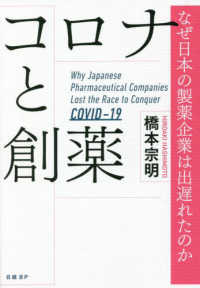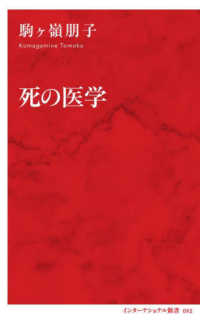出版社内容情報
<英文版>有機薄膜仕事関数データ集
--------------------------------------------------------------------------------
★Indispensable data base for researchers of organic semiconductor devices!
★The HOMO levels of organic semiconductor thin films that are particularly useful for OLEDs are summarized!
★Including organic materials for solar cells, metals and metal oxides!
Book description
--------------------------------------------------------------------------------
This handbook summarizes the highest occupied molecular orbital (HOMO) levels of organic materials and work functions (WF) of metals and metal oxides in their thin film forms, using the PESA (photo-electron spectroscopy in air) system, which was invented by Prof. M. Uda of Waseda University in Tokyo, Japan. Since the unique open counter of this system can measure photoelectrons even in air, we can measure HOMO and WF levels of various materials routinely in a laboratory. This system is commercially available under the product names AC-1 and AC-2, from Riken Keiki Co., and has been widely used to determine HOMO levels of organic thin films in fields such as organic thin-film electronics. To estimate the HOMO levels in organic materials, the oxidation potential as measured by cyclic voltamograph (CV) has been used for a long time. However, since the values gotten from the oxidation potential are sometimes not directly correlated with the HOMO levels in their thin film form because of molecular interactions, the ultraviolet photoelectron spectroscopy (UPS) and PESA techniques have proved to be superior methods for estimating them. Although the conventional UPS method provides us with the detailed electronic state in the valence band, the PESA technique has the advantage of being a rapid and simple procedure for estimating the photoemission threshold. This handbook summarizes the HOMO levels of organic semiconductor thin films that are particularly useful for organic light emitting diodes (OLEDs), which are important applications of organic semiconductor devices. We classified organic materials into three major categories, i.e., hole transport materials (HTL), emitter materials (EML), and electron transport materials (ETM), and have also included in this summary organic materials useful for solar cells, i.e., as metal and metal oxides layers.
We believe that this convenient handbook will help researchers and materials designers in clarifying the energy levels of organic thin films and accelerate development of this rapidly growing research area. (From "Preface")
Authors
--------------------------------------------------------------------------------
Chihaya Adachi Professor, Department of Photonics Materials Science, Chitose Institute of Science & Technology (CIST)
TakahitoOyamada Department of Photonics Materials Science,Chitose Institute of Science & Technology (CIST)
Contents
--------------------------------------------------------------------------------
I.Classification of organic materials in organic light emitting diodes
1. Introduction
2. Electroluminescence mechanics of organic light emitting diodes
3. Excitation formation process in organic light emitting diodes (carrier recombination,formatin of singlet and
triplet excitons in OLEDs)
4. OLED device structures
5. Purification of organic materials by sublimation
6. Hole transport materials
7. Electron transport materials
8. Emitter materials(EML)
9. Dopant materials
10. Electrode materials
<Data Tables> Number of publishing articles
Hole Transport Materials (92 materials)
Emitter Materials (94 materials)
Electron Transport Materials (91 materials)
Organic Solar Cell Materials (9 materials)
Metals (21 metals)
Metal Oxides (3 oxides)







